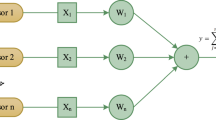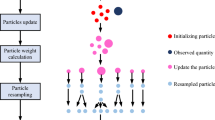Abstract
Smart city applications have increasingly relied on the internet of things (IoT) and edge computing to enable data collection, processing, and communication across distributed networks. Owing to the widespread adoption of IoT and visual object tracking technologies in various domains, traditional visual object tracking techniques are no longer suitable for IoT applications. This paper discusses how image recognition and visual target tracking can be used to enhance track and field training based on IoT technology and reduce coach workload. The purpose of this project aimed to analyze athlete movements, develop customized training plans for track and field athletes, and improve the quality and efficiency of training for track and on-field athletes. This is accomplished by utilizing the edge computing to track moving targets for tracking and field training images. Matching points are extracted from the track and field training images and incorporated into the field-of-view border. Using an invariant projection method based on color information, it is possible to accurately track the movement of the target by analyzing its center position and the distance between field-of-view boundaries. Moreover, a moving target recognition technique based on neural networks is employed for image recognition, utilizing an error back-propagation algorithm to facilitate target recognition in track and field training images. The proposed method is demonstrated to be highly accurate and efficient, thereby reducing the workload of coaches, enabling detailed movement analysis of athletes, and increasing the effectiveness of track and field training. This algorithm has been demonstrated to be more effective than other methods in terms of tracking-effect diagrams and evaluation criteria based on experimental results. Using the proposed algorithm, the occlusion problem can be effectively solved while ensuring real-time tracking performance.










Similar content being viewed by others
Data availability
Enquiries about data availability should be directed to the authors.
References
Ahmed F, Wei L, Niu Y et al (2022) Toward fine-grained access control and privacy protection for video sharing in media convergence environment. Int J Intell Syst 37:3025–3049. https://doi.org/10.1002/int.22810
Ali M, Yin B, Kunar A, Sheikh AM et al (2020) Reduction of multiplications in convolutional neural networks. In: 2020 39th Chinese control conference (CCC). IEEE, pp 7406–7411. https://doi.org/10.23919/CCC50068.2020.9188843
Aslam MS, Tiwari P, Pandey HM, Band SS (2022) Observer–based control for a new stochastic maximum power point tracking for photovoltaic systems with networked control system. IEEE Trans Fuzzy Syst
Aslam MS, Tiwari P, Pandey HM, Band SS, El Sayed H (2023a) A delayed Takagi–Sugeno fuzzy control approach with uncertain measurements using an extended sliding mode observer. Inf Sci 119204
Aslam MS, Tiwari P, Pandey HM, Band SS (2023b) Robust stability analysis for class of Takagi-Sugeno (TS) fuzzy with stochastic process for sustainable hypersonic vehicles. Inf Sci 641:119044
Bilal H, Yin B, Aslam MS et al (2023) A practical study of active disturbance rejection control for rotary flexible joint robot manipulator. Soft Comput 27:4987–5001. https://doi.org/10.1007/s00500-023-08026-x
Campbell MD (2017) Quantifying the behavior of fish in response to a moving camera vehicle by using benthic stereo cameras and target tracking. Fish Bull Natl Ocean Atmos Adm 115(3):343–354
Chen G (2019) An experimental study for the effects of noise on face recognition algorithms under varying illumination. Multimed Tools Appl 78(18):26615–26631. https://doi.org/10.1007/s11042-019-07810-y
Eskandarpour A, Dehghan S, Karimi J (2020) Designing a predictive guidance and control system for maneuverable ground moving target tracking in 3D space using a Hexarotor. J Control 14(3):63–74
Henriques JF, Caseiro R, Martins P, Batista J (2015) High-speed tracking with kernelized correlation filters. IEEE Trans Pattern Anal Mach Intell 37:583–596
Henriques JF, Caseiro R, Martins P, Batista J (2012) Exploiting the circulant structure of tracking-by-detection with kernels. In: Proceedings of the European conference on computer vision, Florence, Italy, 7–13 Oct, pp 702–715
Huan E-Y, Wen G (2020) Transfer learning with deep convolutional neural network for constitution classification with face image. Multimed Tools Appl 79(17–18):11905–11919. https://doi.org/10.1007/s11042-019-08376-5
Huang H, Liu G, Zhang Y, Xiong R (2023) Feature distillation Siamese networks for object tracking. Appl Soft Comput 132:109912. https://doi.org/10.1016/j.asoc.2022.109912
Kumar A, Shaikh AM, Li Y et al (2021) Pruning filters with L1-norm and capped L1-norm for CNN compression. Appl Intell 51:1152–1160. https://doi.org/10.1007/s10489-020-01894-y
Liu S, Li L, Jin M, Hou S, Peng Y (2020) Optimized coefficient vector and sparse representation-based classification method for face recognition. IEEE Access 8:8668–8674. https://doi.org/10.1109/ACCESS.2019.2960928
Luo W, Sun P, Zhong F, Liu W, Zhang T, Wang Y (2020) End-to-end active object tracking and its real-world deployment via reinforcement learning. IEEE Trans Pattern Anal Mach Intell 42(6):1317–1332. https://doi.org/10.1109/TPAMI.2019.2899570
Moujahid D, Elharrouss O, Tairi H (2019) Visual tracking via the conventional disc-harmonic moment invariants and the Bayesian inference framework. Int J Imaging Robot 18(2):26–37
Nai K, Li Z, Gan Y, Wang Q (2023) Robust visual tracking via multitask sparse correlation filters learning. IEEE Trans Neural Netw Learn Syst 34(1):502–515. https://doi.org/10.1109/TNNLS.2021.3097498
Savaglio C, Pace P, Aloi G, Liotta A, Fortino G (2019) Lightweight reinforcement learning for energy efficient communications in wireless sensor networks. IEEE Access 7:29355–29364. https://doi.org/10.1109/ACCESS.2019.2902371
Shit RC, Sharma S, Puthal D, Zomaya AY (2018) Location of things (LoT): a review and taxonomy of sensors localization in IoT infrastructure. IEEE Commun Surv Tutor 20(3):2028–2061. https://doi.org/10.1109/COMST.2018.2798591
Su Z, Li J, Chang J et al (2020) Learning spatial-temporally regularized complementary kernelized correlation filters for visual tracking. Multimed Tools Appl 79:25171–25188. https://doi.org/10.1007/s11042-020-09028-9
Tang Z et al (2019) CityFlow: a city-scale benchmark for multi-target multi-camera vehicle tracking and re-identification. In: 2019 IEEE/CVF conference on computer vision and pattern recognition (CVPR), Long Beach, CA, USA, pp. 8789–8798. https://doi.org/10.1109/CVPR.2019.00900
Tian J, Zhou J, Duan J (2023) Hierarchical services of convolutional neural networks via probabilistic selective encryption. IEEE Trans Serv Comput 16(1):343–355. https://doi.org/10.1109/TSC.2021.3136601
Wang L, Zhai Q, Yin B et al (2019) Second-order convolutional network for crowd counting. In: Proc. SPIE 11198, fourth international workshop on pattern recognition, vol 11198. https://doi.org/10.1117/12.2540362
Yamashita R, Nishio M, Do RKG et al (2018) Convolutional neural networks: an overview and application in radiology. Insights Imaging 9:611–629. https://doi.org/10.1007/s13244-018-0639-9
Yao W, Guo Y, Wu Y, Guo J (2017) Experimental validation of fuzzy PID control of flexible joint system in presence of uncertainties. In: 2017 36th Chinese control conference (CCC). IEEE, pp 4192–4197. https://doi.org/10.23919/ChiCC.2017.8028015
Yin B, Kumar A, Ali M, Zhang J, Yao J (2023) Jerk-bounded trajectory planning for rotary flexible joint manipulator: an experimental approach. Soft Comput 27(7):4029–4039. https://doi.org/10.1007/s00500-023-07923-5
Yin B, Khan J, Wang L, Zhang J, Kumar A (2019) Real-time lane detection and tracking for advanced driver assistance systems. In: 2019 Chinese control conference (CCC). IEEE, pp 6772–6777. https://doi.org/10.23919/ChiCC.2019.8866334
Zhang J, He Y, Wang S (2023) Learning adaptive sparse spatially-regularized correlation filters for visual tracking. IEEE Signal Process Lett 30:11–15. https://doi.org/10.1109/LSP.2023.3238277
Zhao G, Ahonen T, Matas J, Pietikainen M (2012) Rotation-invariant image and video description with local binary pattern features. IEEE Trans Image Process 21(4):1465–1477. https://doi.org/10.1109/TIP.2011.2175739
Funding
No funding was provided for the completion of this study.
Author information
Authors and Affiliations
Corresponding author
Ethics declarations
Conflict of interest
The authors declare that there are no conflicts of interest.
Ethical approval
The paper does not deal with any ethical problems.
Informed consent
We declare that all the authors have informed consent.
Additional information
Publisher's Note
Springer Nature remains neutral with regard to jurisdictional claims in published maps and institutional affiliations.
Rights and permissions
Springer Nature or its licensor (e.g. a society or other partner) holds exclusive rights to this article under a publishing agreement with the author(s) or other rightsholder(s); author self-archiving of the accepted manuscript version of this article is solely governed by the terms of such publishing agreement and applicable law.
About this article
Cite this article
Li, J., Tian, S. & Charoenwattana, S. Smart IoT-based visual target enabled track and field training using image recognition. Soft Comput 27, 12571–12585 (2023). https://doi.org/10.1007/s00500-023-08820-7
Accepted:
Published:
Issue Date:
DOI: https://doi.org/10.1007/s00500-023-08820-7




